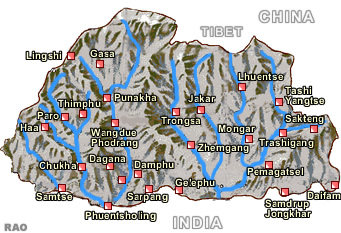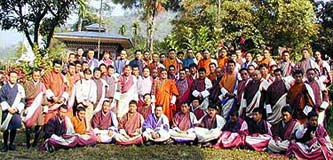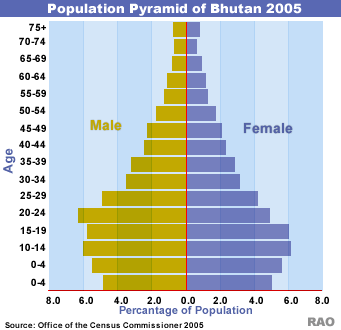| You are here: | RAOnline Home > Travel > Bhutan > Overview > Information > Bhutan at a glance | Search |
 |
| Bhutan at a glance |
|
|
|
|
| Facts & Figures |
|
|
 |

|

|
![]() Climate:
Climate:
Subtropical
monsoon climate in the south; cool moderate climate in central Bhutan;
permanent
frost in the high mountains in the north.
Bhutan
experiences four seasons - spring (March-May), summer (June-August), autumn
(September-November) and winter (December-February). Annual rainfall
is concentrated in the monsoon season from mid-June to September.
(![]() Bhutan's
Climate
Bhutan's
Climate![]() )
)
![]() Location:
Location:
Between
Central and South Asia, bordering Sikkim, India and Tibet; Himalayan foothillsin
the south to high Himalayas in the north; main inhabited region is on a
central plateau (2,000 - 3,000 m above sea level). Bhutan
is a landlocked country, about 300 km long and 150 km wide.
The
entire country is mountainous, the elevation runs from 200 to 7,541 m on
the Tibet border.
The
country has three geographical zones. The southern zone with low forest
hills and dense tropical forests has a hot and humid climate. The central
zone lies between 2,000 and 3,500 m with a semi-tropical climate.
The northern zone lies from east to west between 6,800 and 7,400 m and
is part of the great Himalayas.
(![]() Bhutan Maps
Bhutan Maps![]() )
(
)
(![]() Bhutan's
Forests
Bhutan's
Forests![]() )
(
)
(![]() Bhutan's
Nature
Bhutan's
Nature![]() )
)
 |
![]() Area:
Area:
46,500
km2
![]() Capital:
Capital:
Thimphu;
approximately 40,000 inhabitants (![]() Thimphu
- Capital of Bhutan
Thimphu
- Capital of Bhutan![]() )
)
![]() Population:
Population:
According
to the 2005 Population and Housing Census of Bhutan, the population of
Bhutan is 634,982. Projected population of 762,035 (2015, source: WFP)
 |
|
![]() Time:
Time:
Bhutan
Time is 6 hour ahead of GMT.
Bhutan
Time UTC+0600 or GMT+0600 (Indian
Standard Time)
![]() Languages:
Languages:
Dzongkha
and English (official languages)
In
addition Bumthangkha is spoken in the centre, Sharchopkha in the east, Nepali in the south; a total of 18 different languages are spoken.
Bhotes (Ngalops
and the Sharchops) speak various Tibetan dialects, ethnic Nepalese speak various Nepalese dialects
(![]() Dzongkha-
National Language
Dzongkha-
National Language![]() )
)
 |
![]() Religion:
Religion:
Lamaist
Tantrayana Buddhism (Mahayana Buddhism of the Drukpa sect) = state religion
Buddhist
75%, Indian- and Nepalese-influenced Hinduism 25%
The Ngalongs follow the Drukpa Kagyu school of Tibetan Buddhism, which is Bhutan's
state religion. The Sharchhops follow the Nyingma school of Tibetan
Buddhism. The ethnic Nepalis are predominantly Hindu.
(![]() Bhutan's
Religions
Bhutan's
Religions![]() )
)
 |
![]() National
Day:
National
Day:
December
17 (Coronation of the first Druk Gyalpo
(king) of Bhutan on 17 December 1907)
The
government has declared October 21 as a national holiday on the occasion of the formal accession of
His Royal Highness the Crown Prince Jigme Khesar Namgyel Wangchuck as Chhoetse
Penlop.
Jigme
Khesar Namgyel Wangchuck is the fifth Druk
Gyalpo.(![]() Bhutan's
King
Bhutan's
King![]() )
)
![]() History
History
Bhutan's
early history is steeped in Buddhist tradition and mythology. In
the early twentieth century a hereditary monarchy, with no formal constitution,
was founded and continued the country's policy of isolationism. Under
the Indo-Bhutan Treaty, signed in 1949, Bhutan agreed that its external
affairs would be guided by India. In 1959, Bhutan closed its borders
with Tibet and until now there is no formal diplomatic relations
It is only under the leadership of the third king that Bhutan emerged from its strict isolationism and began to establish links with the global world. Despite the modernization process, Bhutan is very keen on maintaining a careful, controlled policy of development in order to preserve its national identity and national happiness.
![]() Independence:
Independence:
British
protectorate ended in 1949; Indian-Bhutanese Treaty of Friendship
![]() System
of government:
System
of government:
Bhutan
is a constitutional monarchy, now with King Jigme Khesar Namgyel
Wangchuck who is the fifth hereditary King.
The Prime Minister is the head of the government. Bhutan's first elected prime minister was Lyonchhen Jigmi Thinley (Dasho). The persent elected prime minister's name is Lyonchhen Tshering Tobgay.
King
Jigme Khesar Namgyel Wangchuck is head of state of Bhutan.
Bhutan has its own unique political and administrative system. Its approach to development efforts is guided by the concept of maximizing Gross National Happiness, propounded by King Jigme Singye Wangchuk. It forms the basis for identifying directions that are preferred above all others and has directed efforts to improve living standards, including spiritual well-being and preservation of cultural values and the physical environment.
Gross National Happiness places the individual at the center of all development efforts and recognizes that individuals have material, spiritual and emotional needs.
Hereditary
monarchy (since 1907)
December
14, 2006: The fourth Druk Gyalpo, His Majesty Jigme Singye Wangchuck, has
handed over his responsibilities as the Monarch and head of state of Bhutan
to the Crown Prince Jigme Khesar Namgyel Wangchuck who now assumes the
full responsibilities of head of state as the fifth
Druk Gyalpo.
|
( |
Bhutan's first general elections that is electing 47 candidates to the National Assembly were held on 24 March 2008.
| ( |
| ( |
![]() Parliament:
Parliament:
Since
2008 Bhutan has a two chamber parlimamentary system: The Upper House of
parliament, the 25-seat National Council, and the Lower House of
Parliament (National Assembly -
(Tshogdu))
with 47 seats.
The elections were held in December 2007, March 2008 and July 2013.
The government is headed by a Prime Minister. The King is still head o state.
Bhutan has two political parties to date: The Bhutan Peace and Prosperity Party or Bhutan Harmony Party (Druk Phuensum Tshogpa (DPT)) and the People's Democratic Party (PDP).
There is also a Royal Advisory Council (Lodoi Tsokde). The members of the council are nominated by the monarch.
(![]() Bhutan's
National Assembly
Bhutan's
National Assembly![]() )
(
)
(![]() Elections
2008
Elections
2008![]() )
)
![]() Administrative
structure:
Administrative
structure:
Bhutan
has actually 20
administrative districts
(dzongkhags) divided into several blocks
(gewogs). Bhutan's 20 dzongkhags and 205
gewogs would be divided into 47 constituencies with many political parties and candidates.
(![]() Bhutan
Maps
Bhutan
Maps![]() )
)

|
![]() Media:
Media:
Bhutan
Broadcasting Service (BBS) radio only - Since 1999 there have been
a few hours of television daily
Weekly
newspapers ("Kuensel", Bhutan Times) - Internet access, satellite
television
![]() Currency:
Currency:
1
Ngultrum (NU) = 100 chetrums (Ch)
Indian
rupees are legal tender
Bhutanese ngultrum is not convertible. The Bhutanese currency is pegged to the Indian rupee at par, and the rupee can be circulated freely in Bhutan despite that the ngultrum is the only legal tender currency in the country
There
are only two commercial banks in Bhutan with branches around the country:
the Bank of Bhutan and the Bhutan National Bank. In general, there
are exchange counters at the airport, hotels and the two main cities of
Thimphu and Phuentsholing.
(![]() Bhutanese
Stamps & Bank Notes
Bhutanese
Stamps & Bank Notes![]() )
)

|
![]() GDP Gross Domestic Product:
GDP Gross Domestic Product:
approx. US$ 291,331 million (1996)
, approx. US$ 1'810 per c. (2008, source: ITU), GDP growth (% change per year): 7.7% (2012, source: ADB), the country's per capita GDP has more than quintupled, from Nu13,078 in 1981 to Nu69,577 in 2011 (source: ADB 2013)
(![]() Economic
& Social Statistics
Economic
& Social Statistics![]() )
)
![]() Per-capita
income (GNI = gross national income) :
Per-capita
income (GNI = gross national income) :
The per capita income is estimated at USD 2,418 (2014, source: WFP), USD 2,130 (2011, source: ADB)
(![]() Economic
& Social Statistics
Economic
& Social Statistics![]() )
(
)
(![]() Bhutan's
Development
Bhutan's
Development![]() )
)
![]() Natural
resources
Natural
resources
Around
70 per cent of the country is covered with forests, but only less than
8 per cent of the total land area has potential for agricultural production.
The river valleys and flat land most suitable for agriculture are situated
in the southern part of the country, whereas the northern mountainous belt
under snowline is suitable for animal husbandry.
Bhutan
has a potential for hydropower development. The unspoiled natural
environment and its preserved cultural heritage represent a good potential
to develop high quality eco- and cultural tourism.
(![]() Bhutan's
Tourism
Bhutan's
Tourism![]() )
(
)
(![]() Bhutan's
Forests
Bhutan's
Forests![]() )
)
![]() Roads:
Roads:
The road network in Bhutan is divided into 9 categories .
The country has 6.2 km of Expressway accounting for 0.12% of the total road network, 1628.1 km National Highways (30.36%), 482.0 km District Roads (8.99%), 820.7 km Feeder Roads (15.3%), 163 km Urban Roads (3.04%), 1045.6 km Farm Roads (19.5%), 528.9 km Forest Roads (9.86%), 547.2 km Access Roads (10.2%) and 140.8 km of Power Tiller Tracks (2.63%).
(![]() Road Network
Road Network![]() )
)
| Source: Department of Planning, Ministry of Finance, Thimphu and UNESCAP |

|
| Video |
| External Links |

|

|
| Links |
| External Links |
|
ADB Asian
Development Bank
View the video clip Poverty Reduction Bhutan: In Pursuit of Gross National Happiness |
|
|
|
UNDP
Bhutan
Government Official Web portal |
|
|
| Information on Bhutan |
|
|||||||||||||||||||||
|
 |
|
|